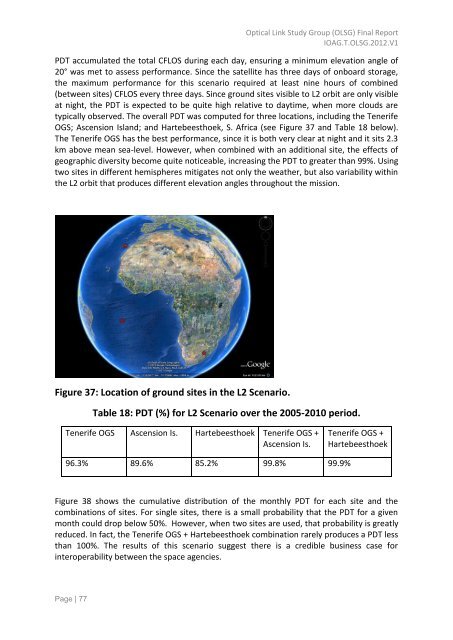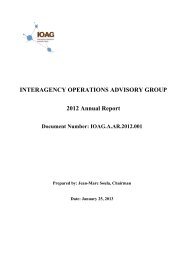OLSG Report_Final_06_05_12 - Interagency Operations Advisory ...
OLSG Report_Final_06_05_12 - Interagency Operations Advisory ...
OLSG Report_Final_06_05_12 - Interagency Operations Advisory ...
Create successful ePaper yourself
Turn your PDF publications into a flip-book with our unique Google optimized e-Paper software.
Optical Link Study Group (<strong>OLSG</strong>) <strong>Final</strong> <strong>Report</strong><br />
IOAG.T.<strong>OLSG</strong>.20<strong>12</strong>.V1<br />
PDT accumulated the total CFLOS during each day, ensuring a minimum elevation angle of<br />
20° was met to assess performance. Since the satellite has three days of onboard storage,<br />
the maximum performance for this scenario required at least nine hours of combined<br />
(between sites) CFLOS every three days. Since ground sites visible to L2 orbit are only visible<br />
at night, the PDT is expected to be quite high relative to daytime, when more clouds are<br />
typically observed. The overall PDT was computed for three locations, including the Tenerife<br />
OGS; Ascension Island; and Hartebeesthoek, S. Africa (see Figure 37 and Table 18 below).<br />
The Tenerife OGS has the best performance, since it is both very clear at night and it sits 2.3<br />
km above mean sea-level. However, when combined with an additional site, the effects of<br />
geographic diversity become quite noticeable, increasing the PDT to greater than 99%. Using<br />
two sites in different hemispheres mitigates not only the weather, but also variability within<br />
the L2 orbit that produces different elevation angles throughout the mission.<br />
Figure 37: Location of ground sites in the L2 Scenario.<br />
Table 18: PDT (%) for L2 Scenario over the 20<strong>05</strong>-2010 period.<br />
Tenerife OGS Ascension Is. Hartebeesthoek Tenerife OGS +<br />
Ascension Is.<br />
Tenerife OGS +<br />
Hartebeesthoek<br />
96.3% 89.6% 85.2% 99.8% 99.9%<br />
Figure 38 shows the cumulative distribution of the monthly PDT for each site and the<br />
combinations of sites. For single sites, there is a small probability that the PDT for a given<br />
month could drop below 50%. However, when two sites are used, that probability is greatly<br />
reduced. In fact, the Tenerife OGS + Hartebeesthoek combination rarely produces a PDT less<br />
than 100%. The results of this scenario suggest there is a credible business case for<br />
interoperability between the space agencies.<br />
Page | 77



